Large-scale gene function analysis with the PANTHER classification system
The PANTHER (protein annotation through evolutionary relationship) classification system (http://www.pantherdb.org/) is a comprehensive system that combines gene function, ontology, pathways and statistical analysis tools that enable biologists to analyze large-scale, genome-wide data from sequencing, proteomics or gene expression experiments. The system is built with 82 complete genomes organized into gene families and subfamilies, and their evolutionary relationships are captured in phylogenetic trees, multiple sequence alignments and statistical models (hidden Markov models or HMMs). Genes are classified according to their function in several different ways: families and subfamilies are annotated with ontology terms (Gene Ontology (GO) and PANTHER protein class), and sequences are assigned to PANTHER pathways. The PANTHER website includes a suite of tools that enable users to browse and query gene functions, and to analyze large-scale experimental data with a number of statistical tests. It is widely used by bench scientists, bioinformaticians, computer scientists and systems biologists. In the 2013 release of PANTHER (v.8.0), in addition to an update of the data content, we redesigned the website interface to improve both user experience and the system's analytical capability. This protocol provides a detailed description of how to analyze genome-wide experimental data with the PANTHER classification system.
This is a preview of subscription content, access via your institution
Access options
Subscribe to this journal
Receive 12 print issues and online access
265,23 € per year
only 22,10 € per issue
Buy this article
- Purchase on SpringerLink
- Instant access to full article PDF
Prices may be subject to local taxes which are calculated during checkout
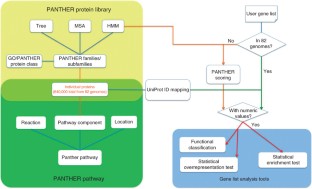
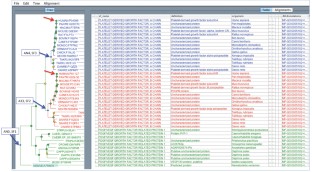
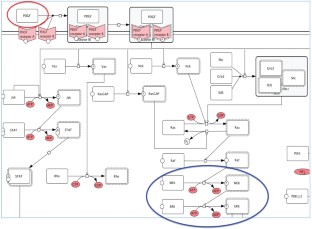
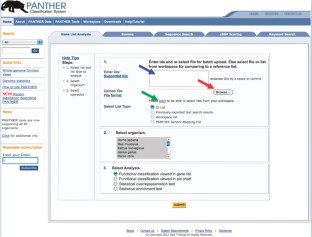

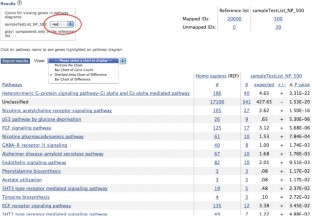
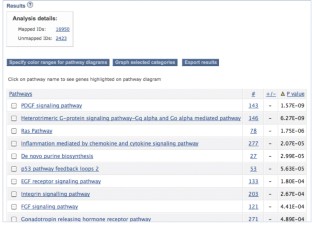
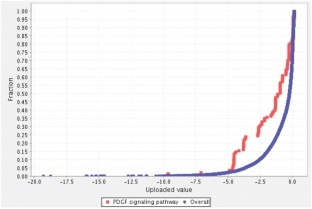
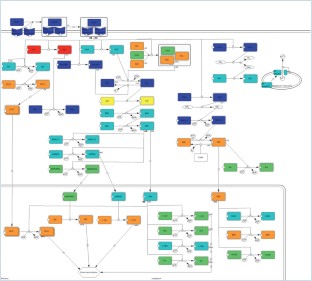
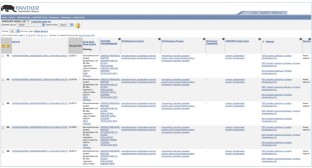
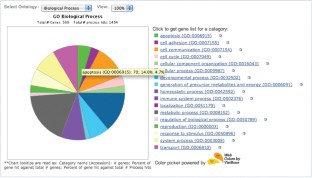
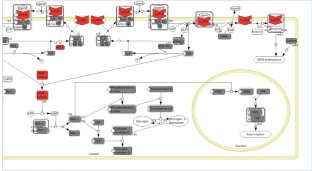
Similar content being viewed by others

The status of the human gene catalogue
Article 04 October 2023
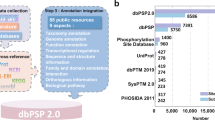
dbPSP 2.0, an updated database of protein phosphorylation sites in prokaryotes
Article Open access 29 May 2020
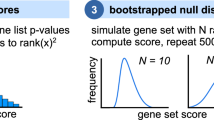
GOAT: efficient and robust identification of gene set enrichment
Article Open access 19 June 2024
References
- Mi, H., Muruganujan, A. & Thomas, P.D. PANTHER in 2013: modeling the evolution of gene function, and other gene attributes, in the context of phylogenetic trees. Nucleic Acids Res.41, D377–D386 (2013). ArticleCASGoogle Scholar
- Venter, J.C. et al. The sequence of the human genome. Science291, 1304–1351 (2001). ArticleCASGoogle Scholar
- Thomas, P.D. et al. PANTHER: a library of protein families and subfamilies indexed by function. Genome Res.13, 2129–2141 (2003). ArticleCASGoogle Scholar
- Thomas, P.D. et al. Applications for protein sequence-function evolution data: mRNA/protein expression analysis and coding SNP scoring tools. Nucleic Acids Res.34, W645–W650 (2006). ArticleGoogle Scholar
- Mi, H. et al. Assessment of genome-wide protein function classification for Drosophila melanogaster. Genome Res.13, 2118–2128 (2003). ArticleCASGoogle Scholar
- Mi, H. et al. The PANTHER database of protein families, subfamilies, functions and pathways. Nucleic Acids Res.33, D284–D288 (2005). ArticleCASGoogle Scholar
- Mi, H. & Thomas, P. PANTHER pathway: an ontology-based pathway database coupled with data analysis tools. Methods Mol. Biol.563, 123–140 (2009). ArticleCASGoogle Scholar
- Funahashi, A. et al. CellDesigner 3.5: a versatile modeling tool for biochemical networks. Proc. IEEE96, 1254–1265 (2008). ArticleGoogle Scholar
- van Baarsen, L.G.M. et al. Gene expression profiling in autoantibody-positive patients with arthralgia predicts development of arthritis. Arthritis Rheum.62, 694–704 (2010). ArticleCASGoogle Scholar
- Verma, G., Bhatia, H. & Datta, M. Gene expression profiling and pathway analysis identify the integrin signaling pathway to be altered by IL-1β in human pancreatic cancer cells: role of JNK. Cancer Lett.320, 86–95 (2012). ArticleCASGoogle Scholar
- Boyer, A.P., Collier, T.S., Vidavsky, I. & Bose, R. Quantitative proteomics with siRNA screening identifies novel mechanisms of trastuzumab resistance in HER2-amplified breast cancers. Mol. Cell Proteomics12, 180–193 (2013). ArticleGoogle Scholar
- Stützer, I. et al. Systematic proteomic analysis identifies β-site amyloid precursor protein cleaving enzyme 2 and 1 (BACE2 and BACE1) substrates in pancreatic beta cells. J. Biol. Chem.288, 10536–10547 (2013). ArticleGoogle Scholar
- Shi, Y. et al. Genome-wide association study identified eight new risk loci for polycystic ovary syndrome. Nat. Genet.44, 1020–1025 (2012). ArticleCASGoogle Scholar
- den Hoed, M. et al. Identification of heart rate–associated loci and their effects on cardiac conduction and rhythm disorders. Nat. Genet.45, 621–631 (2013). ArticleCASGoogle Scholar
- Feng, J. et al. Dnmt1 and Dnmt3a maintain DNA methylation and regulate synaptic function in adult forebrain neurons. Nat. Neurosci.13, 423–430 (2010). ArticleCASGoogle Scholar
- Hek, K. et al. A genome-wide association study of depressive symptoms. Biol. Psychiatr.73, 667–678 (2013). ArticleCASGoogle Scholar
- Neely, G.G. et al. A global in vivo Drosophila RNAi screen identifies NOT3 as a conserved regulator of heart function. Cell141, 142–153 (2010). ArticleCASGoogle Scholar
- McDowall, J. & Hunter, S. InterPro protein classification. Methods Mol. Biol.694, 37–47 (2011). ArticleCASGoogle Scholar
- Gene Ontology Consortium. The Gene Ontology: enhancements for 2011. Nucleic Acids Res.40, D559–D564 (2012).
- Mi, H. et al. PANTHER version 7: improved phylogenetic trees, orthologs and collaboration with the Gene Ontology Consortium. Nucleic Acids Res.38, D204–D210 (2010). ArticleCASGoogle Scholar
- Reference Genome Group of the Gene Ontology Consortium. The Gene Ontology's Reference Genome Project: a unified framework for functional annotation across species. PLoS Comput. Biol.5, e1000431 (2009).
- Gaudet, P., Livstone, M.S., Lewis, S.E. & Thomas, P.D. Phylogenetic-based propagation of functional annotations within the Gene Ontology consortium. Brief Bioinform.12, 449–462 (2011). ArticleGoogle Scholar
- Cerami, E.G. et al. Pathway Commons, a web resource for biological pathway data. Nucleic Acids Res.39, D685–D690 (2010). ArticleGoogle Scholar
- Thomas, P.D. GIGA: a simple, efficient algorithm for gene tree inference in the genomic age. BMC Bioinformatics11, 312 (2010). ArticleGoogle Scholar
- Le Novere, N. BioModels Database—a database of annotated published models http://www.ebi.ac.uk/biomodels-main/static-pages.do?page=home (2011).
- Hucka, M . et al. The systems biology markup language (SBML): a medium for representation and exchange of biochemical network models. Bioinformatics19, 524–531 (2003). ArticleCASGoogle Scholar
- Demir, E. et al. The BioPAX community standard for pathway data sharing. Nat. Biotech.28, 935–942 (2010). ArticleCASGoogle Scholar
- Cho, R.J. & Campbell, M.J. Transcription, genomes, function. Trends Genet.16, 409–415 (2000). ArticleCASGoogle Scholar
- Clark, A.G. et al. Inferring non-neutral evolution from human-chimp-mouse orthologous gene trios. Science302, 1960–1963 (2003). ArticleCASGoogle Scholar
- Mootha, V.K. et al. Identification of a gene causing human cytochrome c oxidase deficiency by integrative genomics. Proc. Natl. Acad. Sci. USA100, 605–610 (2003). ArticleCASGoogle Scholar
- Mann, H.B. & Whitney, D.R. On a test of whether one of two random variables is stochastically larger than the other. Ann. Math. Statist.18, 50–60 (1947). ArticleGoogle Scholar
- Subramanian, A. et al. Gene set enrichment analysis: a knowledge-based approach for interpreting genome-wide expression profiles. Proc. Natl. Acad. Sci. USA102, 15545–15550 (2005). ArticleCASGoogle Scholar
- Sherman, B. et al. DAVID Knowledgebase: a gene-centered database integrating heterogeneous gene annotation resources to facilitate high-throughput gene functional analysis. BMC Bioinformatics8, 426 (2007). ArticleGoogle Scholar
Acknowledgements
We thank the Reference Proteome team, especially C. McAnulla and M. Martin, for their support in providing up-to-date Reference Proteome data set, and we thank Y. Matsuoka and K. Manami from the Systems Biology Institute Japan for their support on CellDesigner and pathway file update. This work is supported by the US National Institutes of Health (NIH)/National Institute of General Medical Sciences (NIGMS) grant no. GM081084 to P.D.T. Funding for open access was provided by the University of Southern California.
Author information
Authors and Affiliations
- Department of Preventive Medicine, Division of Bioinformatics, Keck School of Medicine, University of Southern California, Los Angeles, California, USA Huaiyu Mi, Anushya Muruganujan, John T Casagrande & Paul D Thomas
- Huaiyu Mi
















